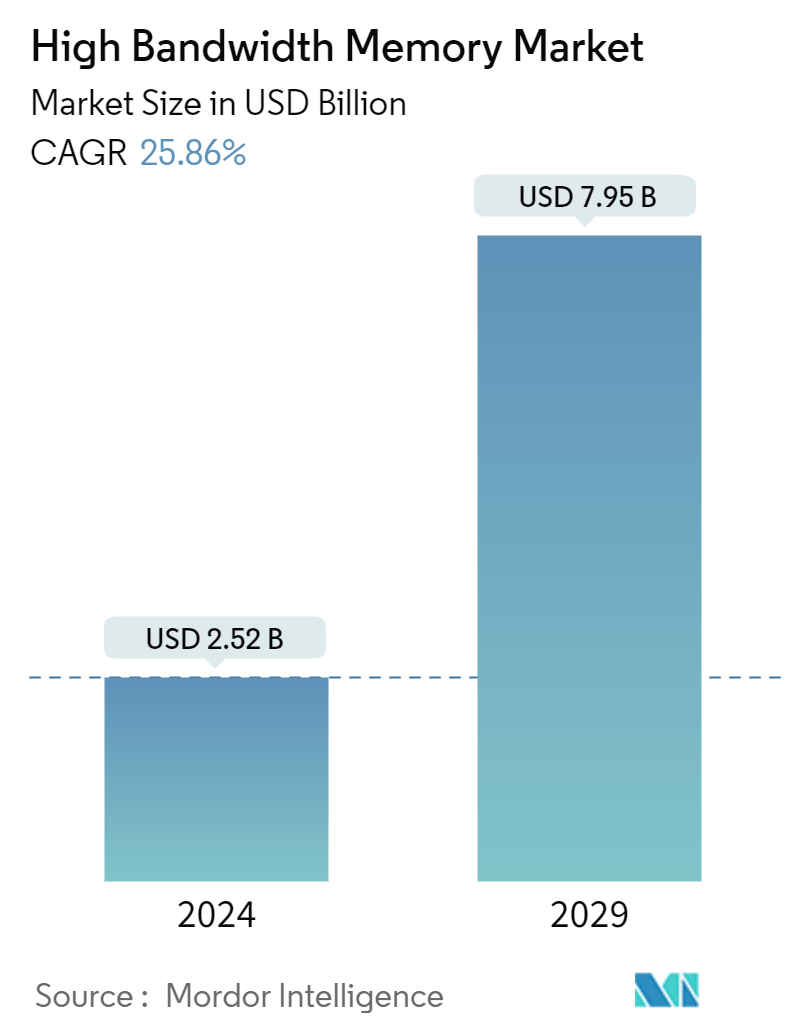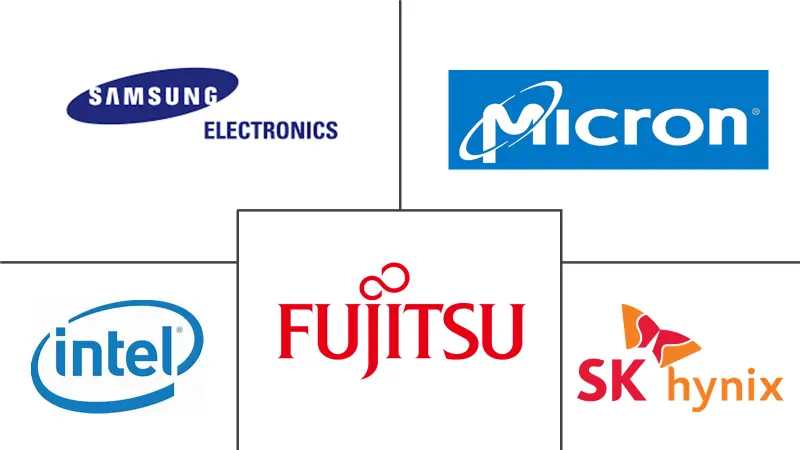Market Size of High Bandwidth Memory Industry

| Study Period | 2019 - 2029 |
| Market Size (2024) | USD 2.52 Billion |
| Market Size (2029) | USD 7.95 Billion |
| CAGR (2024 - 2029) | 25.86 % |
| Fastest Growing Market | Asia Pacific |
| Largest Market | North America |
Major Players
*Disclaimer: Major Players sorted in no particular order |
High Bandwidth Memory Market Analysis
The High Bandwidth Memory Market size is estimated at USD 2.52 billion in 2024, and is expected to reach USD 7.95 billion by 2029, growing at a CAGR of 25.86% during the forecast period (2024-2029).
High bandwidth memory (HBM) is a high-speed computer memory interface for 3D-stacked SDRAM, usually used with high-performance graphics accelerators, network devices, and supercomputers.
Major factors driving the growth of the high bandwidth memory (HBM) market include the growing need for high bandwidth, low power, and highly scalable memories, increasing adoption of artificial intelligence, and a rising trend of miniaturization of electronic devices.
By stacking up 8 DRAM dies on the circuit and interconnecting them with TSVs, HBM offers a substantially higher bandwidth while using less power in a relatively minor form factor. Also, with 128-bit channels and a total of 8 channels, the HBM offers a 1,024-bit interface. A GPU with four HBM stacks would provide a memory bus with 4,096 bits.
For instance, in June 2024, US memory chip maker Micron Technology built test production lines for advanced high bandwidth memory chips in the United States. The company is considering manufacturing HBM in Malaysia for the first time to capture more demand from the AI boom.
With the growing graphics application, the appetite for fast information delivery (bandwidth) has also increased. Therefore, HBM performs better than GDDR5, which was used earlier in terms of performance and power efficiency, resulting in growth opportunities for the high bandwidth memory market.
Moreover, the major semiconductor vendors worked with reduced capacity due to the COVID-19 pandemic. Additionally, due to the shortage of laborers, many packages and testing plants in China reduced or even stopped operations. This created a bottleneck for chip companies that rely on such back-end packages and testing capacity.
However, some factors driving the market's growth include the increasing adoption of artificial intelligence, increasing demand for low power consumption, high bandwidth, highly scalable memories, and a rising trend of miniaturization of electronic devices.
High Bandwidth Memory Industry Segmentation
High bandwidth memory (HBM) is the high-speed computer memory interface for 3D-stacked synchronous dynamic random-access memory (SDRAM). It works with high-performance network hardware, high-performance data center AI ASICs, FPGAs, and supercomputers.
The high bandwidth memory (HBM) market is segmented by application (servers, networking, consumer, and automotive and other applications) and geography (North America [United States and Canada], Europe [Germany, France, United Kingdom, and Rest of Europe], Asia-Pacific [India, China, Japan, and Rest of Asia-Pacific], and Rest of the World).
The market sizes and forecasts are provided in terms of value (USD) for all the above segments.
| By Application | |
| Servers | |
| Networking | |
| Consumer | |
| Automotive and Other Applications |
| By Geography | ||||||
| ||||||
| ||||||
| ||||||
| Rest of the World |
High Bandwidth Memory Market Size Summary
The High Bandwidth Memory (HBM) market is poised for significant growth, driven by the increasing demand for high-speed, low-power, and scalable memory solutions. This demand is largely fueled by the rising adoption of artificial intelligence and the trend towards miniaturization of electronic devices. HBM technology, which involves stacking multiple DRAM dies to enhance bandwidth while reducing power consumption, is becoming increasingly popular in high-performance applications such as graphics accelerators, network devices, and supercomputers. The automotive sector, particularly with the rise of self-driving cars and advanced driver-assistance systems (ADAS), is also contributing to the market's expansion as these technologies require rapid data processing capabilities. The transition from traditional memory solutions like GDDR5 to HBM is driven by the need for better performance and efficiency, further propelling market growth.
In North America, the HBM market is experiencing robust growth due to the surge in high-performance computing applications, which demand efficient memory solutions for fast data processing. The region's focus on artificial intelligence, machine learning, and cloud computing is a significant driver of this demand. Additionally, initiatives like the Data Center Optimization Initiative (DCOI) are promoting the consolidation and enhancement of data centers, which further supports the need for high-bandwidth memory solutions. The competitive landscape of the HBM market is characterized by several major players, including Intel Corporation, Toshiba Corporation, and Fujitsu Ltd, who are continually innovating and expanding their production capabilities. Recent developments, such as Intel's launch of the Sapphire Rapids processor and SK Hynix's advancement in HBM3 technology, highlight the industry's commitment to enhancing memory performance and capacity, ensuring the market's dynamic growth trajectory.
High Bandwidth Memory Market Size - Table of Contents
-
1. MARKET INSIGHTS
-
1.1 Market Overview
-
1.2 Industry Value Chain Analysis
-
1.3 Industry Attractiveness - Porter's Five Forces Analysis
-
1.3.1 Bargaining Power of Suppliers
-
1.3.2 Bargaining Power of Buyers/Consumers
-
1.3.3 Threat of New Entrants
-
1.3.4 Threat of Substitutes
-
1.3.5 Intensity of Competitive Rivalry
-
-
1.4 Assessment of the Impact of COVID-19 on the Market
-
1.5 Market Drivers
-
1.5.1 Growing Need for High Bandwidth, Low Power Consuming, and Highly Scalable Memories
-
1.5.2 Increasing Adoption of Artificial Intelligence
-
1.5.3 Rising Trend of Miniaturization of Electronic Devices
-
-
1.6 Market Challenges
-
1.6.1 Exorbitant Costs and Design Complexities Associated with HBM
-
-
1.7 DRAM MARKET
-
1.7.1 DRAM Revenue and Demand Forecast (2023-2028)
-
1.7.2 DRAM Revenue by Geography (Same Geographical Regions as in the HBM Market)
-
1.7.3 Current Pricing of DDR5 RAM Products
-
1.7.4 List of DDR5 Product Manufacturers
-
-
-
2. MARKET SEGMENTATION
-
2.1 By Application
-
2.1.1 Servers
-
2.1.2 Networking
-
2.1.3 Consumer
-
2.1.4 Automotive and Other Applications
-
-
2.2 By Geography
-
2.2.1 North America
-
2.2.1.1 United States
-
2.2.1.2 Canada
-
-
2.2.2 Europe
-
2.2.2.1 Germany
-
2.2.2.2 France
-
2.2.2.3 United Kingdom
-
2.2.2.4 Rest of Europe
-
-
2.2.3 Asia-Pacific
-
2.2.3.1 India
-
2.2.3.2 China
-
2.2.3.3 Japan
-
2.2.3.4 Rest of Asia-Pacific
-
-
2.2.4 Rest of the World
-
-
High Bandwidth Memory Market Size FAQs
How big is the High Bandwidth Memory Market?
The High Bandwidth Memory Market size is expected to reach USD 2.52 billion in 2024 and grow at a CAGR of 25.86% to reach USD 7.95 billion by 2029.
What is the current High Bandwidth Memory Market size?
In 2024, the High Bandwidth Memory Market size is expected to reach USD 2.52 billion.

